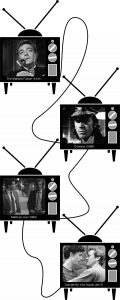The complicated history of queer representation in film
November 13, 2019
Throughout history, the negative depiction of the LGBTQ community in film has directly influenced how queer people are treated by society.
During the classical Hollywood period from the early 1920s to late ‘50s, homosexuality was only insinuated through the use of stereotypes and innuendo. Men perceived as homosexual would exhibit feminine features such as having a perfumed scent, being soft-spoken, moving about in a “dainty” fashion or being physically weaker than the leading male protagonist.
This indirect way of identifying a gay character is referred to as “gay coding.”
Gay coding itself isn’t a bad thing, but often in classical Hollywood, gay coding was indicative of nefarious characters.
“The Maltese Falcon” (1941) has an infamous scene with such coding. Joel Cairo, played by Peter Lorre, is introduced by his gardenia-scented business cards. His queerness is further implied by his seemingly delicate  nature and the subtle yet suggestive way he handles his cane.
nature and the subtle yet suggestive way he handles his cane.
In this scene the protagonist, Samuel Spade, remains suspicious of Joel’s intent due to these attributes. His suspicions prove true once Joel pulls a gun on him. This sort of representation negatively impacted society’s view of gay people because they were seen as untrustworthy and promiscuous, not to mention immoral to those of strong religious faith.
This contributed to the lack of protection granted to queer people who could be indefinitely banned from federal government, teaching positions and even office jobs.
The effects of these stereotypes are still seen today. Not every state within the U.S. provides legal job protection regardless of sex or gender.
Flash forward to 1980 when “Cruising” was released. This film features a murderous psychopath among an S&M New York subculture.
The homosexual insinuations within the film were nowhere near vague. There was a blunt and direct connection between crime and homosexuality.
In a society that was against anything other than heteronormativity, these promiscuous and villainous acts were ascribed to the LGBTQ community as a whole. The response from audiences was vastly different from thirty years prior. The backlash from the queer community started before the movie even finished filming.
Over time, both Hollywood films and independent films became more friendly to the homosexual community.
In 1982, 20th Century Fox released “Making Love,” which depicted a married man’s realization of his own homosexuality. The film highlighted his coming out story and even gave him a happy ending.
“Making Love” deserves credit for not shying away from openly depicting a gay character. Though this was a step in the right direction, the focus centered too much around his sexuality. The complexity of his personality was overshadowed by his discovery and struggle with his own sexuality.
So where is the balance between depicting a queer antagonist and LGBTQ visibility? Can evil characters be queer without the filmmakers being perceived as homophobic?
The answer lies in the portrayal of flawed queer characters who say things they regret, have troubles at work, have addictions, swear too much in front of children and so on. Queer people should be written in films as flawed human beings that deal with the same struggles as everyone else.
That’s why independent films today such as “Call Me By Your Name” (2017) have earned so many accolades. This film is a beautiful love story that focuses on the struggles in a relationship that everyone experiences. It doesn’t focus solely on the sexuality of the main characters.
Though great strides have been made in LGBTQ representation in independent film, there are still major problems with big budget Hollywood films. Because China represents a large part of the market for major studios, and bans elements of homosexuality, studios like Disney often give queer characters roles so minor that they can be cut out.
This begs the question, what is the point of having queer representation if the studio cuts it for Chinese distribution? Can it be considered true queer representation if cutting out the queer characters doesn’t affect the original plot of the film?
These big budget films pander to queer audiences with hints of queer content, but aren’t fully invested in the importance of inclusion. Profit is the driving factor.
The deeper problem lies, once again, in the implied meaning of these actions. By creating queer characters that can easily be cut from film, Hollywood production companies are telling the LGBTQ population that they will pander to homophobic nations so long as it allows them to make a profit.
This tells the LGBTQ population that they are more concerned with turning a profit than standing up to homophobic societies.
Out of 109 major studio releases in 2017 researched by GLAAD, roughly 13% had LGBTQ characters. Of these films, about 64% featured gay men, 36% featured lesbians, 14% featured bisexuals and 0% featured trans-inclusive content.
There is a huge disparity of representation equality within the LGBTQ community in cinema. Why does this matter? Haven’t we come far enough?
Yes, it matters, and we still have a long way to go.
Society is still being impacted by the lack of queer representation. In 2017, Donald Trump placed a ban on transgender people serving in our military.
How is this different from queer people being banned from federal government in the 1950s? Here’s the answer: it’s not.
Though this deficit in queer representation in film is not the leading cause of such bans, it is certainly a contributing factor. As a gay person, this scares the hell out of me.
To this day, depending on the state, I could be legally fired because of my sexuality. If trans people can be banned from the military, I can only imagine what sort of bans or laws might be applied to lesbians.
This is precisely why equal representation and visibility among the queer community in film or any other medium is vital to our survival.













